NCERT Solution for Class 10 Mathematics Chapter 1 - Real Numbers Page/Excercise 1.1
YOU CAN SEE VIDEO LECTURE -
Question 1
Use Euclid's division algorithm to find the HCF of:
(i) 135 and 225
(ii) 196 and 38220
(iii) 867 and 255
(i) 135 and 225
(ii) 196 and 38220
(iii) 867 and 255
Solution 1
(i) 135 and 225
Step 1: Since 225 > 135, apply Euclid's division lemma, to a =225 and b=135 to find q and r such that 225 = 135q+r, 0 r<135
r<135
On dividing 225 by 135 we get quotient as 1 and remainder as 90
i.e 225 = 135 x 1 + 90
Step 2: Remainder r which is 90 0, we apply Euclid's division lemma to b =135 and r = 90 to find whole numbers q and r such that
0, we apply Euclid's division lemma to b =135 and r = 90 to find whole numbers q and r such that
135 = 90 x q + r, 0 r<90
r<90
On dividing 135 by 90 we get quotient as 1 and remainder as 45
i.e 135 = 90 x 1 + 45
Step 3: Again remainder r = 45 0 so we apply Euclid's division lemma to b =90 and r = 45 to find q and r such that
0 so we apply Euclid's division lemma to b =90 and r = 45 to find q and r such that
90 = 90 x q + r, 0 r<45
r<45
On dividing 90 by 45 we get quotient as 2 and remainder as 0
i.e 90 = 2 x 45 + 0
Step 4: Since the remainder is zero, the divisor at this stage will be HCF of (135, 225).
Since the divisor at this stage is 45, therefore, the HCF of 135 and 225 is 45.
(ii) 196 and 38220
Step 1: Since 38220 > 196, apply Euclid's division lemma
to a =38220 and b=196 to find whole numbers q and r such that
38220 = 196 q + r, 0 r < 196
r < 196
On dividing 38220 we get quotient as 195 and remainder r as 0
i.e 38220 = 196 x 195 + 0
Since the remainder is zero, divisor at this stage will be HCF
Since divisor at this stage is 196 , therefore, HCF of 196 and 38220 is 196.
NOTE: HCF( a,b) = a if a is a factor of b. Here, 196 is a factor of 38220 so HCF is 196.
(iii) 867 and 255
Step 1: Since 867 > 255, apply Euclid's division lemma, to a =867 and b=255 to find q and r such that 867 = 255q + r, 0 r<255
r<255
On dividing 867 by 255 we get quotient as 3 and remainder as 102
i.e 867 = 255 x 3 + 102
Step 2: Since remainder 102 0, we apply the division lemma to a=255 and b= 102 to find whole numbers q and r such that
0, we apply the division lemma to a=255 and b= 102 to find whole numbers q and r such that
255 = 102q + r where 0 r<102
r<102
On dividing 255 by 102 we get quotient as 2 and remainder as 51
i.e 255 = 102 x 2 + 51
Step 3: Again remainder 51 is non zero, so we apply the division lemma to a=102 and b= 51 to find whole numbers q and r such that
102 = 51 q + r where 0 r < 51
On dividing 102 by 51 quotient is 2 and remainder is 0
i.e 102 = 51 x 2 + 0
Since the remainder is zero, the divisor at this stage is the HCF
Since the divisor at this stage is 51,therefore, HCF of 867 and 255 is 51.
Concept Insight: To crack such problem remember to apply the Euclid's division Lemma which states that "Given positive integers a and b, there exists unique integers q and r satisfying a = bq + r, where 0 r < b" in the correct order.
r < b" in the correct order.
Here, a > b.
Euclid's algorithm works since Dividing 'a' by 'b', replacing 'b' by 'r' and 'a' by 'b' and repeating the process of division till remainder 0 is reached, gives a number which divides a and b exactly.
i.e HCF(a,b) =HCF(b,r)
Note that do not find the HCF using prime factorisation in this question when the method is specified and do not skip steps.
Step 1: Since 225 > 135, apply Euclid's division lemma, to a =225 and b=135 to find q and r such that 225 = 135q+r, 0
 r<135
r<135On dividing 225 by 135 we get quotient as 1 and remainder as 90
i.e 225 = 135 x 1 + 90
Step 2: Remainder r which is 90
 0, we apply Euclid's division lemma to b =135 and r = 90 to find whole numbers q and r such that
0, we apply Euclid's division lemma to b =135 and r = 90 to find whole numbers q and r such that135 = 90 x q + r, 0
 r<90
r<90On dividing 135 by 90 we get quotient as 1 and remainder as 45
i.e 135 = 90 x 1 + 45
Step 3: Again remainder r = 45
 0 so we apply Euclid's division lemma to b =90 and r = 45 to find q and r such that
0 so we apply Euclid's division lemma to b =90 and r = 45 to find q and r such that90 = 90 x q + r, 0
 r<45
r<45On dividing 90 by 45 we get quotient as 2 and remainder as 0
i.e 90 = 2 x 45 + 0
Step 4: Since the remainder is zero, the divisor at this stage will be HCF of (135, 225).
Since the divisor at this stage is 45, therefore, the HCF of 135 and 225 is 45.
(ii) 196 and 38220
Step 1: Since 38220 > 196, apply Euclid's division lemma
to a =38220 and b=196 to find whole numbers q and r such that
38220 = 196 q + r, 0
 r < 196
r < 196On dividing 38220 we get quotient as 195 and remainder r as 0
i.e 38220 = 196 x 195 + 0
Since the remainder is zero, divisor at this stage will be HCF
Since divisor at this stage is 196 , therefore, HCF of 196 and 38220 is 196.
NOTE: HCF( a,b) = a if a is a factor of b. Here, 196 is a factor of 38220 so HCF is 196.
(iii) 867 and 255
Step 1: Since 867 > 255, apply Euclid's division lemma, to a =867 and b=255 to find q and r such that 867 = 255q + r, 0
 r<255
r<255On dividing 867 by 255 we get quotient as 3 and remainder as 102
i.e 867 = 255 x 3 + 102
Step 2: Since remainder 102
 0, we apply the division lemma to a=255 and b= 102 to find whole numbers q and r such that
0, we apply the division lemma to a=255 and b= 102 to find whole numbers q and r such that255 = 102q + r where 0
 r<102
r<102On dividing 255 by 102 we get quotient as 2 and remainder as 51
i.e 255 = 102 x 2 + 51
Step 3: Again remainder 51 is non zero, so we apply the division lemma to a=102 and b= 51 to find whole numbers q and r such that
102 = 51 q + r where 0 r < 51
On dividing 102 by 51 quotient is 2 and remainder is 0
i.e 102 = 51 x 2 + 0
Since the remainder is zero, the divisor at this stage is the HCF
Since the divisor at this stage is 51,therefore, HCF of 867 and 255 is 51.
Concept Insight: To crack such problem remember to apply the Euclid's division Lemma which states that "Given positive integers a and b, there exists unique integers q and r satisfying a = bq + r, where 0
 r < b" in the correct order.
r < b" in the correct order.Here, a > b.
Euclid's algorithm works since Dividing 'a' by 'b', replacing 'b' by 'r' and 'a' by 'b' and repeating the process of division till remainder 0 is reached, gives a number which divides a and b exactly.
i.e HCF(a,b) =HCF(b,r)
Note that do not find the HCF using prime factorisation in this question when the method is specified and do not skip steps.
Question 2
Show that any positive odd integer is of the form 6q + 1, or 6q + 3, or 6q + 5, where q is some integer.
Solution 2
Let a be any odd positive integer we need to prove that a is of the form 6q + 1 , or 6q + 3 , or 6q + 5 , where q is some integer.
Since a is an integer consider b = 6 another integer applying Euclid's division lemma we get
a = 6q + r for some integer q 0, and r = 0, 1, 2, 3, 4, 5 since
0, and r = 0, 1, 2, 3, 4, 5 since
0 r < 6.
r < 6.
Therefore, a = 6q or 6q + 1 or 6q + 2 or 6q + 3 or 6q + 4 or 6q + 5
However since a is odd so a cannot take the values 6q, 6q+2 and 6q+4
(since all these are divisible by 2)
Also, 6q + 1 = 2 x 3q + 1 = 2k1 + 1, where k1 is a positive integer
6q + 3 = (6q + 2) + 1 = 2 (3q + 1) + 1 = 2k2 + 1, where k2 is an integer
6q + 5 = (6q + 4) + 1 = 2 (3q + 2) + 1 = 2k3 + 1, where k3 is an integer
Clearly, 6q + 1, 6q + 3, 6q + 5 are of the form 2k + 1, where k is an integer.
Therefore, 6q + 1, 6q + 3, 6q + 5 are odd numbers.
Therefore, any odd integer can be expressed is of the form
6q + 1, or 6q + 3, or 6q + 5 where q is some integer
Concept Insight: In order to solve such problems Euclid's division lemma is applied to two integers a and b the integer b must be taken in accordance with what is to be proved, for example here the integer b was taken 6 because a must be of the form 6q + 1, 6q + 3, 6q + 5.
Basic definition of even and odd numbers and the fact that addition and , multiplication of integers is always an integer are applicable here.
Since a is an integer consider b = 6 another integer applying Euclid's division lemma we get
a = 6q + r for some integer q
 0, and r = 0, 1, 2, 3, 4, 5 since
0, and r = 0, 1, 2, 3, 4, 5 since0
 r < 6.
r < 6.Therefore, a = 6q or 6q + 1 or 6q + 2 or 6q + 3 or 6q + 4 or 6q + 5
However since a is odd so a cannot take the values 6q, 6q+2 and 6q+4
(since all these are divisible by 2)
Also, 6q + 1 = 2 x 3q + 1 = 2k1 + 1, where k1 is a positive integer
6q + 3 = (6q + 2) + 1 = 2 (3q + 1) + 1 = 2k2 + 1, where k2 is an integer
6q + 5 = (6q + 4) + 1 = 2 (3q + 2) + 1 = 2k3 + 1, where k3 is an integer
Clearly, 6q + 1, 6q + 3, 6q + 5 are of the form 2k + 1, where k is an integer.
Therefore, 6q + 1, 6q + 3, 6q + 5 are odd numbers.
Therefore, any odd integer can be expressed is of the form
6q + 1, or 6q + 3, or 6q + 5 where q is some integer
Concept Insight: In order to solve such problems Euclid's division lemma is applied to two integers a and b the integer b must be taken in accordance with what is to be proved, for example here the integer b was taken 6 because a must be of the form 6q + 1, 6q + 3, 6q + 5.
Basic definition of even and odd numbers and the fact that addition and , multiplication of integers is always an integer are applicable here.
Question 3
An army contingent of 616 members is to march behind an army band of 32 members in a parade. The two groups are to march in the same number of columns. What is the maximum number of columns in which they can march?
Solution 3
Maximum number of columns in which the Army contingent and the band can march will be given by HCF (616, 32)
We can use Euclid's algorithm to find the HCF.
Step 1: since 616 > 32 so applying Euclid's division lemma to a= 616 and b= 32 we get integers q and r as 32 and 19
i.e 616 = 32 x 19 + 8
Step 2: since remainder r =8 0 so again applying Euclid's lemma to 32 and 8 we get integers 4 and 0 as the quotient and remainder
0 so again applying Euclid's lemma to 32 and 8 we get integers 4 and 0 as the quotient and remainder
i.e 32 = 8 x 4 + 0
Step 3: Since remainder is zero so divisor at this stage will be the HCF
The HCF (616, 32) is 8.
Therefore, they can march in 8 columns each.
Concept Insight: In order to solve the word problems first step is to interpret the problem and identify what is to be determined. The key word "Maximum" means we need to find the HCF.Do not forget to write the unit in the answer.
We can use Euclid's algorithm to find the HCF.
Step 1: since 616 > 32 so applying Euclid's division lemma to a= 616 and b= 32 we get integers q and r as 32 and 19
i.e 616 = 32 x 19 + 8
Step 2: since remainder r =8
 0 so again applying Euclid's lemma to 32 and 8 we get integers 4 and 0 as the quotient and remainder
0 so again applying Euclid's lemma to 32 and 8 we get integers 4 and 0 as the quotient and remainder i.e 32 = 8 x 4 + 0
Step 3: Since remainder is zero so divisor at this stage will be the HCF
The HCF (616, 32) is 8.
Therefore, they can march in 8 columns each.
Concept Insight: In order to solve the word problems first step is to interpret the problem and identify what is to be determined. The key word "Maximum" means we need to find the HCF.Do not forget to write the unit in the answer.
Question 4
Use Euclid's division lemma to show that the square of any positive integer is either of form 3m or 3m + 1 for some integer m.
Solution 4
Let a be any positive integer we need to prove that a2 is of the form 3m or 3m + 1 for some integer m.
Let b = 3 be the other integer so applying Euclid's division lemma to a and b=3
We get a = 3q + r for some integer q 0and r = 0, 1, 2
0and r = 0, 1, 2
Therefore, a = 3q or 3q + 1 or 3q + 2
Now Consider a2
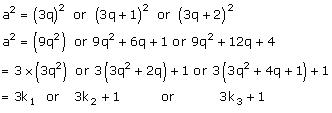
Where k1 = 3q2, k2 =3q2+2q and k3 = 3q2+4q+1 since q ,2,3,1 etc are all integers so is their sum and product.
So k1 k2 k3 are all integers.
Hence, it can be said that the square of any positive integer is either of the form 3m or 3m + 1 for any integer m.
Concept Insight: In order to solve such problems Euclid's division lemma is applied to two integers a and b the integer b must be taken in accordance with what is to be proved, for example here the integer b was taken 3 because a must be of the form3m or 3m + 1. Do not forget to take a2. Note that variable is just a notation and not the absolute value.
Let b = 3 be the other integer so applying Euclid's division lemma to a and b=3
We get a = 3q + r for some integer q
 0and r = 0, 1, 2
0and r = 0, 1, 2Therefore, a = 3q or 3q + 1 or 3q + 2
Now Consider a2

Where k1 = 3q2, k2 =3q2+2q and k3 = 3q2+4q+1 since q ,2,3,1 etc are all integers so is their sum and product.
So k1 k2 k3 are all integers.
Hence, it can be said that the square of any positive integer is either of the form 3m or 3m + 1 for any integer m.
Concept Insight: In order to solve such problems Euclid's division lemma is applied to two integers a and b the integer b must be taken in accordance with what is to be proved, for example here the integer b was taken 3 because a must be of the form3m or 3m + 1. Do not forget to take a2. Note that variable is just a notation and not the absolute value.
Question 5
Use Euclid's division lemma to show that the cube of any positive integer is of the form 9m, 9m + 1 or 9m + 8.
Solution 5
Let a be any positive integer and b = 3
a = 3q + r, where q 0 and 0
0 and 0 r < 3
r < 3

Therefore, every number can be represented as these three forms. There are three cases.
Case 1: When a = 3q,

Where m is an integer such that m = 3q3
Case 2: When a = 3q + 1,
a3 = (3q +1)3
a3 = 27q3 + 27q2 + 9q + 1
a3 = 9(3q3 + 3q2 + q) + 1
a3 = 9m + 1
Where m is an integer such that m = (3q3 + 3q2 + q)
Case 3: When a = 3q + 2,
a3 = (3q +2)3
a3 = 27q3 + 54q2 + 36q + 8
a3 = 9(3q3 + 6q2 + 4q) + 8
a3 = 9m + 8
Where m is an integer such that m = (3q3 + 6q2 + 4q)
Therefore, the cube of any positive integer is of the form 9m, 9m + 1,
or 9m + 8.
Concept Insight: In this problem Euclid's division lemma can be applied to integers a and b = 9 as well but using 9 will give us 9 values of r and hence as many cases so solution will be lengthy. Since every number which is divisible by 9 is also divisible by 3 so 3 is used.
Do not forget to take a3 and all the different values of a i.e

a = 3q + r, where q
 0 and 0
0 and 0 r < 3
r < 3Therefore, every number can be represented as these three forms. There are three cases.
Case 1: When a = 3q,
Where m is an integer such that m = 3q3
Case 2: When a = 3q + 1,
a3 = (3q +1)3
a3 = 27q3 + 27q2 + 9q + 1
a3 = 9(3q3 + 3q2 + q) + 1
a3 = 9m + 1
Where m is an integer such that m = (3q3 + 3q2 + q)
Case 3: When a = 3q + 2,
a3 = (3q +2)3
a3 = 27q3 + 54q2 + 36q + 8
a3 = 9(3q3 + 6q2 + 4q) + 8
a3 = 9m + 8
Where m is an integer such that m = (3q3 + 6q2 + 4q)
Therefore, the cube of any positive integer is of the form 9m, 9m + 1,
or 9m + 8.
Concept Insight: In this problem Euclid's division lemma can be applied to integers a and b = 9 as well but using 9 will give us 9 values of r and hence as many cases so solution will be lengthy. Since every number which is divisible by 9 is also divisible by 3 so 3 is used.
Do not forget to take a3 and all the different values of a i.e
NCERT Solution for Class 10 Mathematics Chapter 1 - Real Numbers Page/Excercise 1.2
Question 1
Express each number as product of its prime factors:
(i) 140
(ii) 156
(iii) 3825
(iv) 5005
(v) 7429
(i) 140
(ii) 156
(iii) 3825
(iv) 5005
(v) 7429
Solution 1
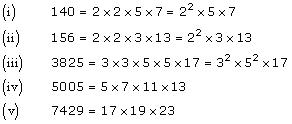
Concept Insight: Since the given number needs to be expressed as the product of prime factors so in order to solve this problem knowing prime numbers is required. Do not forget to put the exponent in case a prime number is repeating.
Question 2
Find the LCM and HCF of the following pairs of integers and verify that LCM x HCF = product of the two numbers.
(i) 26 and 91
(ii) 510 and 92
(iii) 336 and 54
(i) 26 and 91
(ii) 510 and 92
(iii) 336 and 54
Solution 2
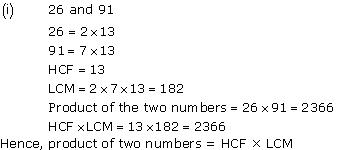
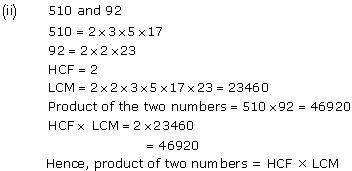
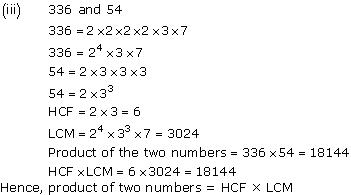
Concept Insight: HCF is the product of common prime factors raised to least power, while LCM is product of prime factors raised to highest power. HCF is always a factor of the LCM.
Do not skip verification product of two numbers = HCF x LCM as it can help in cross checking the answer.
Question 3
Find the LCM and HCF of the following integers by applying the prime factorisation method.
(i) 12, 15 and 21
(ii) 17, 23, 29
(iii) 8, 9 and 25
(i) 12, 15 and 21
(ii) 17, 23, 29
(iii) 8, 9 and 25
Solution 3
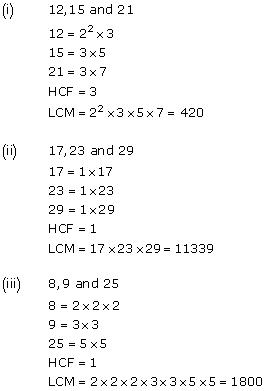
Concept Insight: HCF is the product of common prime factors of all three numbers raised to least power, while LCM is product of prime factors of all here raised to highest power. Use the fact that HCF is always a factor of the LCM to verify the answer. Note HCF of (a,b,c) can also be calculated by taking two numbers at a time i.e HCF (a,b) and then HCF (b,c) .
Question 4
Given that HCF (306, 657) = 9, find LCM (306, 657).
Solution 4
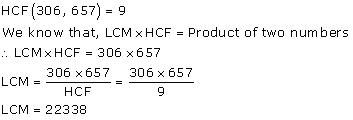
Concept Insight: This problem must be solved using product of two numbers = HCF x LCM rather then prime factorisation
Question 5
Check whether 6n can end with the digit 0 for any natural number n.
Solution 5
If any number ends with the digit 0, it should be divisible by 10 or in other words its prime factorisation must include primes 2 and 5 both
Prime factorisation of 6n = (2 x 3)n
By Fundamental Theorem of Arithmetic Prime factorisation of a number is unique. So 5 is not a prime factor of 6n.
Hence, for any value of n, 6n will not be divisible by 5.
Therefore, 6n cannot end with the digit 0 for any natural number n.
Concept Insight: In order solve such problems the concept used is if a number is to end with zero then it must be divisible by 10 and the prime factorisation of a number is unique.
Prime factorisation of 6n = (2 x 3)n
By Fundamental Theorem of Arithmetic Prime factorisation of a number is unique. So 5 is not a prime factor of 6n.
Hence, for any value of n, 6n will not be divisible by 5.
Therefore, 6n cannot end with the digit 0 for any natural number n.
Concept Insight: In order solve such problems the concept used is if a number is to end with zero then it must be divisible by 10 and the prime factorisation of a number is unique.
Question 6
Explain why 7 x 11 x 13 + 13 and 7 x 6 x 5 x 4 x 3 x 2 x 1 + 5 are composite numbers.
Solution 6
Numbers are of two types - prime and composite. Prime numbers has only two factors namely 1 and the number itself whereas composite numbers have factors other than 1 and itself.
It can be observed that
7 x 11 x 13 + 13 = 13 x (7 x 11 + 1) = 13 x (77 + 1)
= 13 x 78
= 13 x 13 x 6
The given expression has 6 and 13 as its factors. Therefore, it is a composite number.
7 x 6 x 5 x 4 x 3 x 2 x 1 + 5 = 5 x (7 x 6 x 4 x 3 x 2 x 1 + 1)
= 5 x (1008 + 1)
= 5 x 1009
1009 cannot be factorised further. Therefore, the given expression has 5 and 1009 as its factors. Hence, it is a composite number.
Concept Insight: Definition of prime numbers and composite numbers is used. Do not miss the reasoning.
It can be observed that
7 x 11 x 13 + 13 = 13 x (7 x 11 + 1) = 13 x (77 + 1)
= 13 x 78
= 13 x 13 x 6
The given expression has 6 and 13 as its factors. Therefore, it is a composite number.
7 x 6 x 5 x 4 x 3 x 2 x 1 + 5 = 5 x (7 x 6 x 4 x 3 x 2 x 1 + 1)
= 5 x (1008 + 1)
= 5 x 1009
1009 cannot be factorised further. Therefore, the given expression has 5 and 1009 as its factors. Hence, it is a composite number.
Concept Insight: Definition of prime numbers and composite numbers is used. Do not miss the reasoning.
Question 7
There is a circular path around a sports field. Sonia takes 18 minutes to drive one round of the field, while Ravi takes 12 minutes for the same. Suppose they both start at the same point and at the same time, and go in the same direction. After how many minutes will they meet again at the starting point?
Solution 7
It can be observed that Ravi and Sonia does not take same amount of time Ravi takes lesser time than Sonia for completing 1 round of the circular path.
As they are going in the same direction, they will meet again at the same time when Ravi will have completed 1 round of that circular path with respect to Sonia.
i.e When Sonia completes one round then ravi completes 1.5 rounds. So they will meet first time at the time which is a common multiple of the time taken by them to complete 1 round
i.e LCM of 18 minutes and 12 minutes.
Now
18 = 2 x 3 x 3 = 2 x 32
And, 12 = 2 x 2 x 3 = 22 x 3
LCM of 12 and 18 = product of factors raised to highest exponent =
22 x 32 = 36
Therefore, Ravi and Sonia will meet together at the starting point after 36 minutes.
Concept Insight: In order to solve the word problems first step is to interpret the problem and identify what is to be determined. The problem asks for simultaneous reoccurrence of events so we need to find LCM. The key word for simultaneous reoccurrence of events is LCM. Do not forget to write the final answer.
As they are going in the same direction, they will meet again at the same time when Ravi will have completed 1 round of that circular path with respect to Sonia.
i.e When Sonia completes one round then ravi completes 1.5 rounds. So they will meet first time at the time which is a common multiple of the time taken by them to complete 1 round
i.e LCM of 18 minutes and 12 minutes.
Now
18 = 2 x 3 x 3 = 2 x 32
And, 12 = 2 x 2 x 3 = 22 x 3
LCM of 12 and 18 = product of factors raised to highest exponent =
22 x 32 = 36
Therefore, Ravi and Sonia will meet together at the starting point after 36 minutes.
Concept Insight: In order to solve the word problems first step is to interpret the problem and identify what is to be determined. The problem asks for simultaneous reoccurrence of events so we need to find LCM. The key word for simultaneous reoccurrence of events is LCM. Do not forget to write the final answer.
NCERT Solution for Class 10 Mathematics Chapter 1 - Real Numbers Page/Excercise 1.3
Question 1

Solution 1
Let us assume, on the contrary that  is a rational number.
is a rational number.
 is a rational number.
is a rational number.
Therefore, we can find two integers a,b (b # 0) such that  =
= 
 =
= 
Where a and b are co-prime integers.

Therefore, a2 is divisible by 5 then a is also divisible by 5.
So a = 5k, for some integer k.
This means that b2 is divisible by 5 and hence, b is divisible by 5.
This implies that a and b have 5 as a common factor.
And this is a contradiction to the fact that a and b are co-prime.
Concept Insight: There are various ways of proving in mathematics proof by contradiction is one of them. In this approach we assume something which is contrary to what needs to be proved and arrive at a fact which contradicts something which is true in general. Key result used here is "If P is a prime number and it divides a2then it divides a as well".
Question 2

Solution 2
Therefore, we can find two integers a, b (b
 0) such that
0) such that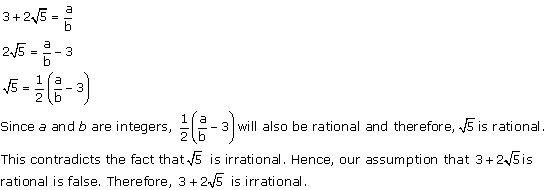
Concept Insight: This problem is solved using proof by contradiction. The key concept used is if p is prime number then
Question 3
Prove that the following are irrationals:

Solution 3
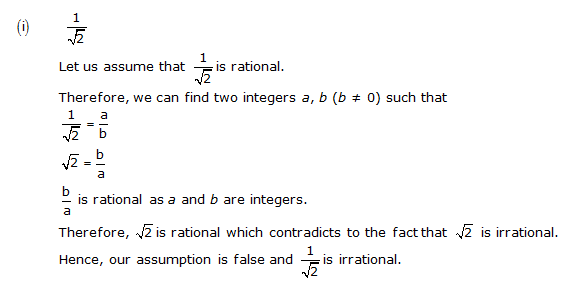
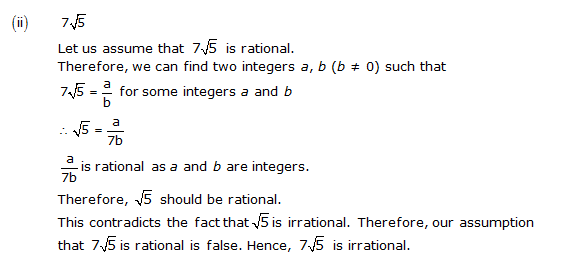
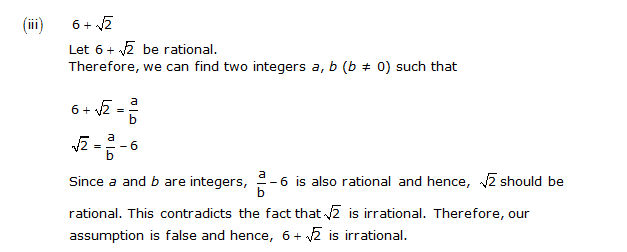
Concept Insight: This problem is solved using proof by contradiction. The key concept used is if p is prime number then
NCERT Solution for Class 10 Mathematics Chapter 1 - Real Numbers Page/Excercise 1.4
Question 1
Without actually performing the long division, state whether the following rational numbers will have a terminating decimal expansion or a non-terminating repeating decimal expansion:


Solution 1
3125 = 55
The denominator is of the form 5m.

8 = 23
The denominator is of the form 2m.

455 = 5 x 7 x 13
Since the denominator is not in the form 2m x 5n, and it also contains 7 and 13 as its factors, its decimal expansion will be non-terminating repeating.
The denominator is of the form 2m x 5n.
343 = 73
Since the denominator is not in the form 2m x 5n, and it has 7 as its factor,

The denominator is of the form 2m x 5n. Hence, the decimal expansion of
 is terminating. (vii)
is terminating. (vii) 
Since the denominator is not of the form 2m 5n, and it also has 7 as its

The denominator is of the form 5n.
10 = 2 x 5
The denominator is of the form 2m x 5n.

30 = 2 x 3 x 5
Since the denominator is not of the form 2m
Concept Insight: The concept used in this problem is that
The decimal expansion of rational number
terminates if and only if the prime factorisation of q is of the form 2n5m, where n and m are non negative integers. Do not forget that 0 is also a non negative integer so n or m can take value 0.
Generally mistake is committed in identifying terminating decimals when either of the two prime numbers 2 or 5 is appearing in the prime factorisation.
Question 2
Write down the decimal expansions of those rational numbers in Question 1 above which have terminating decimal expansions.
Solution 2
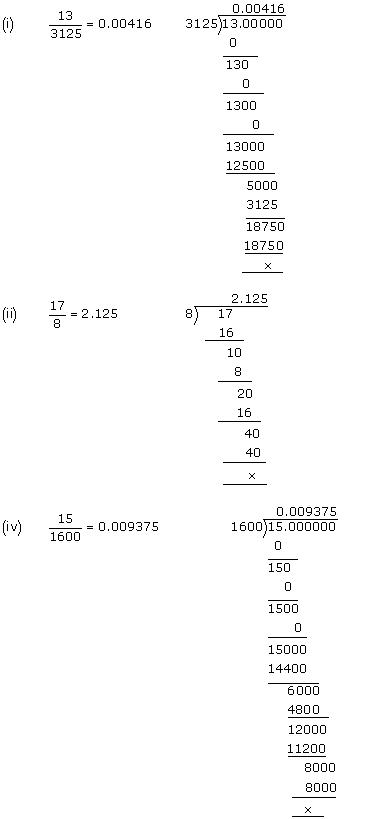
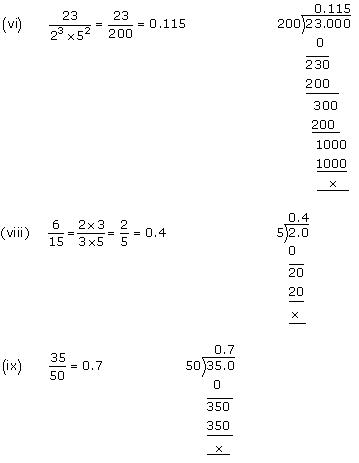
Concept Insight: This is based on performing the long division and expressing the rational number in the decimal form learnt in lower classes.
Question 3
The following real numbers have decimal expansions as given below. In each case, decide whether they are rational or not. If they are rational, and of the form  , what can you say about the prime factor of q?
, what can you say about the prime factor of q?

 , what can you say about the prime factor of q?
, what can you say about the prime factor of q?
Solution 3
(i) 43.123456789
Since this number has a terminating decimal expansion, it is a rational number of the form and q is of the form 2m x 5n,
and q is of the form 2m x 5n,
i.e., the prime factors of q will be either 2 or 5 or both.
(ii) 0.120120012000120000...
The decimal expansion is neither terminating nor recurring. Therefore, the given number is an irrational number.

Since the decimal expansion is non-terminating recurring, the given number is a rational number of the form and q is not of the form 2m x 5n i.e., the prime factors of q will also have a
and q is not of the form 2m x 5n i.e., the prime factors of q will also have a
factor other than 2 or 5.
Concept Insight: The concept used in this problem is that,
Since this number has a terminating decimal expansion, it is a rational number of the form
i.e., the prime factors of q will be either 2 or 5 or both.
(ii) 0.120120012000120000...
The decimal expansion is neither terminating nor recurring. Therefore, the given number is an irrational number.
Since the decimal expansion is non-terminating recurring, the given number is a rational number of the form
factor other than 2 or 5.
Concept Insight: The concept used in this problem is that,
If the decimal expansion of rational number  , [where p and q are coprime numbers] terminates, then prime factorization of q is of the form 2n5m, where n and m are non negative integers.
, [where p and q are coprime numbers] terminates, then prime factorization of q is of the form 2n5m, where n and m are non negative integers.
 , [where p and q are coprime numbers] terminates, then prime factorization of q is of the form 2n5m, where n and m are non negative integers.
, [where p and q are coprime numbers] terminates, then prime factorization of q is of the form 2n5m, where n and m are non negative integers.
No comments:
Post a Comment